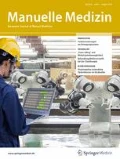Zusammenfassung
Aufgrund der demographischen Entwicklung in Österreich kommt den Veränderungen im Alter eine immer größere Bedeutung zu. Ab dem 55. Lebensjahr kommt es zu einer 15%igen Abnahme der Muskelkraft pro Jahrzehnt, die sich ab dem 70. Lebensjahr auf 30% pro Jahrzehnt beschleunigt. Der Abbau der skelettalen Muskelmasse im Altersverlauf führt zu gravierenden Veränderungen in der Bewegungsqualität und -sicherheit. Der Kraftverlust hat Auswirkungen auf die Bewältigung verschiedenster Alltagsaktivitäten, eventuell verbunden mit funktionellen Einschränkungen und Invalidität sowie Sturzgefahr. Die altersbedingte Sarkopenie beruht vor allem auf neurogenen Mechanismen, der Ernährung, hormonellen und immunologischen Faktoren sowie körperlicher Inaktivität. Betroffen sind >50% aller Personen ab 80 Jahren.
Zu den physikalischen Behandlungsmöglichkeiten gehören die Bewegungstherapie, Krafttraining, die neuromuskuläre Elektrostimulation und Sensomotoriktraining. Nach ärztlicher Abklärung von Kontraindikationen und bei adäquater Progression sowie besonnener Auswahl der Übungen treten Nebenwirkungen oder Verletzungen bei hochintensivem Krafttraining nicht vermehrt auf. Krafttraining mindert nachweislich das Sturzrisiko. Sensomotoriktraining beeinflusst das Gleichgewicht, die Standstabilität und die Gehgeschwindigkeit positiv, wodurch ebenfalls das Sturzrisiko reduziert wird.
Abstract
Due to the demographic development in Austria age-related alterations in the elderly are becoming more important. After 55 years of age a 15% decrease in muscle strength occurs per decade which increases to 30% after 70 years of age. The reduction in skeletal muscle mass in the course of aging leads to severe alterations in the quality of movement and sureness of movement. The loss of strength has an effect on the ability to cope with a wide variety of daily activities, possibly associated with functional limitations and disability as well as the risk of falls. Age-related sarcopenia is based in particular on neurogenic mechanisms, nutrition, hormonal and immunological factors and physical activity. More than 50% of persons older than 80 years are affected.
The physical treatment options include therapeutic exercises, strength training, neuromuscular electrostimulation and sensorimotor training. Following medical clarification of contraindications, adequate progression and a sensible selection of exercises, side effects or injuries do not occur more often by highly intensive training. Strength training has been proven to reduce the risk of falls. Sensorimotor training positively influences the equilibrium, stability of standing and speed of walking and also reduces the risk of falls.
Literatur
Jette AM, Branch LG (1981) The Framingham Disability Study: II. Physical disability among the aging. Am J Public Health 71:1211–1216
Imamura K, Ashida H, Ishikawa T, Fujii M (1983) Human major psoas muscle and sacrospinalis muscle in relation to age: a study by computed tomography. J Gerontol 38:678–681
Evans W (1997) Functional and metabolic consequences of sarcopenia. J Nutr 127:998–1003
Frontera WR, Meredith CN, O’Reilly KP et al (1988) Strength conditioning in older men: skeletal muscle hypertrophy and improved function. J Appl Physiol 64:1038–1044
Mayer F, Baur H, Müller S et al. (2004) Prävention von Beschwerden des Stütz- und Bewegungsapparates. MMW Fortschr Med 146:31–33
Dyrek D (2000) Strength training. Harv Mens Health Watch 5:1–5
Liu CJ, Latham NK (2009) Progressive resistance strength training for improving physical function in older adults. Cochrane Database Syst Rev (3):CD002759
Persch LN, Ugrinowitsch C, Pereira G, Rodacki AL (2009) Strength training improves fall-related gait kinematics in the elderly: a randomized controlled trial. Clin Biomech (Bristol, Avon) 24(:819–825
Ramsbottom R, Ambler A, Potter J et al (2004) The effect of 6 months training on leg power, balance, and functional mobility of independently living adults over 70 years old. J Aging Phys Act 12:497–510
Province MA, Hadley EC, Hornbrook MC et al (1995) The effects of exercise on falls in elderly patients. A preplanned meta-analysis of the FICSIT trials. Frailty and injuries: cooperative studies of intervention techniques. JAMA 273:1341–1347
Interessenkonflikt
Der korrespondierende Autor gibt an, dass kein Interessenkonflikt besteht.
Author information
Authors and Affiliations
Corresponding author
Rights and permissions
About this article
Cite this article
Pieber, K. Altersassoziierte Veränderungen der Muskulatur. Manuelle Medizin 49, 469–470 (2011). https://doi.org/10.1007/s00337-011-0876-1
Published:
Issue Date:
DOI: https://doi.org/10.1007/s00337-011-0876-1

